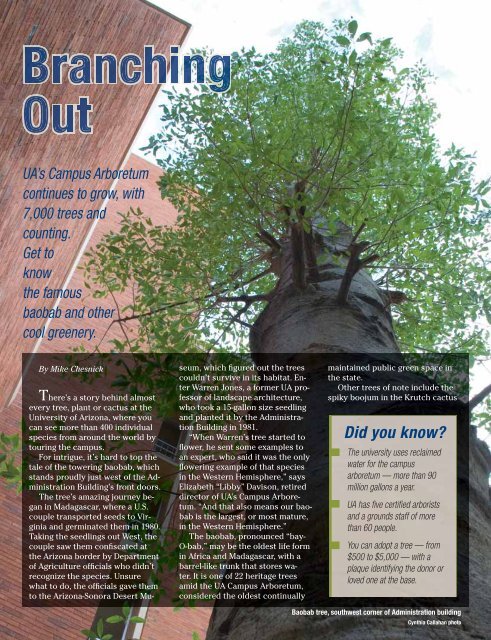WALK THIS WAY - Arizona Daily Wildcat - University of Arizona
WALK THIS WAY - Arizona Daily Wildcat - University of Arizona
WALK THIS WAY - Arizona Daily Wildcat - University of Arizona
You also want an ePaper? Increase the reach of your titles
YUMPU automatically turns print PDFs into web optimized ePapers that Google loves.
UA’s Campus Arboretum<br />
continues to grow, with<br />
7,000 trees and<br />
counting.<br />
Get to<br />
know<br />
the famous<br />
baobab and other<br />
cool greenery.<br />
By Mike Chesnick<br />
There’s a story behind almost<br />
every tree, plant or cactus at the<br />
<strong>University</strong> <strong>of</strong> <strong>Arizona</strong>, where you<br />
can see more than 400 individual<br />
species from around the world by<br />
touring the campus.<br />
For intrigue, it’s hard to top the<br />
tale <strong>of</strong> the towering baobab, which<br />
stands proudly just west <strong>of</strong> the Administration<br />
Building’s front doors.<br />
The tree’s amazing journey began<br />
in Madagascar, where a U.S.<br />
couple transported seeds to Virginia<br />
and germinated them in 1980.<br />
Taking the seedlings out West, the<br />
couple saw them confi scated at<br />
the <strong>Arizona</strong> border by Department<br />
<strong>of</strong> Agriculture <strong>of</strong>fi cials who didn’t<br />
recognize the species. Unsure<br />
what to do, the <strong>of</strong>fi cials gave them<br />
to the <strong>Arizona</strong>-Sonora Desert Mu-<br />
seum, which fi gured out the trees<br />
couldn’t survive in its habitat. Enter<br />
Warren Jones, a former UA pr<strong>of</strong>essor<br />
<strong>of</strong> landscape architecture,<br />
who took a 15-gallon size seedling<br />
and planted it by the Administration<br />
Building in 1981.<br />
“When Warren’s tree started to<br />
fl ower, he sent some examples to<br />
an expert, who said it was the only<br />
fl owering example <strong>of</strong> that species<br />
in the Western Hemisphere,” says<br />
Elizabeth “Libby” Davison, retired<br />
director <strong>of</strong> UA’s Campus Arboretum.<br />
“And that also means our baobab<br />
is the largest, or most mature,<br />
in the Western Hemisphere.”<br />
The baobab, pronounced “bay-<br />
O-bab,” may be the oldest life form<br />
in Africa and Madagascar, with a<br />
barrel-like trunk that stores water.<br />
It is one <strong>of</strong> 22 heritage trees<br />
amid the UA Campus Arboretum,<br />
considered the oldest continually<br />
maintained public green space in<br />
the state.<br />
Other trees <strong>of</strong> note include the<br />
spiky boojum in the Krutch cactus<br />
Did you know?<br />
The university uses reclaimed<br />
water for the campus<br />
arboretum — more than 90<br />
million gallons a year.<br />
UA has fi ve certifi ed arborists<br />
and a grounds staff <strong>of</strong> more<br />
than 60 people.<br />
You can adopt a tree — from<br />
$500 to $5,000 — with a<br />
plaque identifying the donor or<br />
loved one at the base.<br />
Baobab tree, southwest corner <strong>of</strong> Administration building<br />
Cynthia Callahan photo




